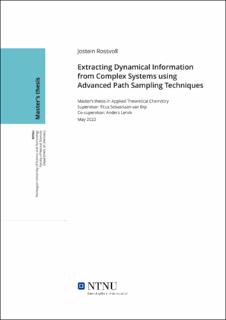| dc.contributor.advisor | van Erp, Titus Sebastiaan. | |
| dc.contributor.advisor | Lervik, Anders. | |
| dc.contributor.author | Rossvoll, Jostein. | |
| dc.date.accessioned | 2022-07-21T17:20:39Z | |
| dc.date.available | 2022-07-21T17:20:39Z | |
| dc.date.issued | 2022 | |
| dc.identifier | no.ntnu:inspera:109833266:70773827 | |
| dc.identifier.uri | https://hdl.handle.net/11250/3007630 | |
| dc.description.abstract | Databaserte simuleringsteknikker spiller en gradvis større rolle som både en erstatning og en utfyllende rolle til eksperimentell forskning, siden disse teknikkene er mindre kostbare og kan gi mikroskopisk dynamisk informasjon. Av spesiell interesse er "path sampling" teknikker som TIS og nyligere RETIS, som lover raskere anskaffelse av dynamisk informasjon som ratekonstanter. Det er derfor viktig å videre utvikle disse metodene med nye "moves" for å senke kostnaden og forbedre resultater. "Wire fencing" er en ny "move" under utvikling som ble testet ut på et system bestående av kadmium selen krystaller. Kadmium selen nanokrystaller er under utvikling og forskning nanostrukturerte halvledere i flere applikasjoner. Disse krystallene har to stabile strukturer, wurtzite og rocksalt i tillegg til en metastabil h-MgO struktur. Gjennom molekylær dynamikk og "path sampling" ble det funnet at en 2048 atom CdSe krystall produserte en planar defekt som senket overgangstrykket mellom wurtzite og rocksalt fra 11 GPa i en perfekt krystall til 9 GPa. Trykket ble identifisert som primærfaktoren i overgangen. "Wire fencing" økte akseptansraten til simuleringene men ga en lengre simuleringstid enn konvensjonelle teknikker. | |
| dc.description.abstract | Computer based simulation techniques are becoming ever more important as both a substitution and compliment to experimental research, since they are less costly and can provide microscopical dynamical information which otherwise is unattainable. Of particular interest are path sampling techniques such as TIS and more recently RETIS, which promises ever faster attainment of dynamical information such as rate constants. It is therefore of importance to further develop these methods with new moves to decrease cost and improve upon results. The wire fencing move is a new move under development which was tested out on a system of cadmium selenide crystals. Cadmium selenide nanocrystals are under development as a nanostructured semiconductor in several applications. Such crystals possess two stable structures, wurtzite and rocksalt as well as a metastable h-MgO structure. By utilising molecular dynamics and path sampling, we found that a 2048 atom CdSe crystal produced a plane defect which lowered the transition pressure between the wurtzite and rocksalt structure from 11 GPa in a perfect crystal to 9 GPa. Pressure was found to be the driving factor facilitating transition. The wire fencing move was found to raise the acceptance rate of trajectories but provided an overall higher simulation time than conventional moves. | |
| dc.language | eng | |
| dc.publisher | NTNU | |
| dc.title | Extracting Dynamical Information from Complex Systems using Advanced Path Sampling Techniques | |
| dc.type | Master thesis | |
